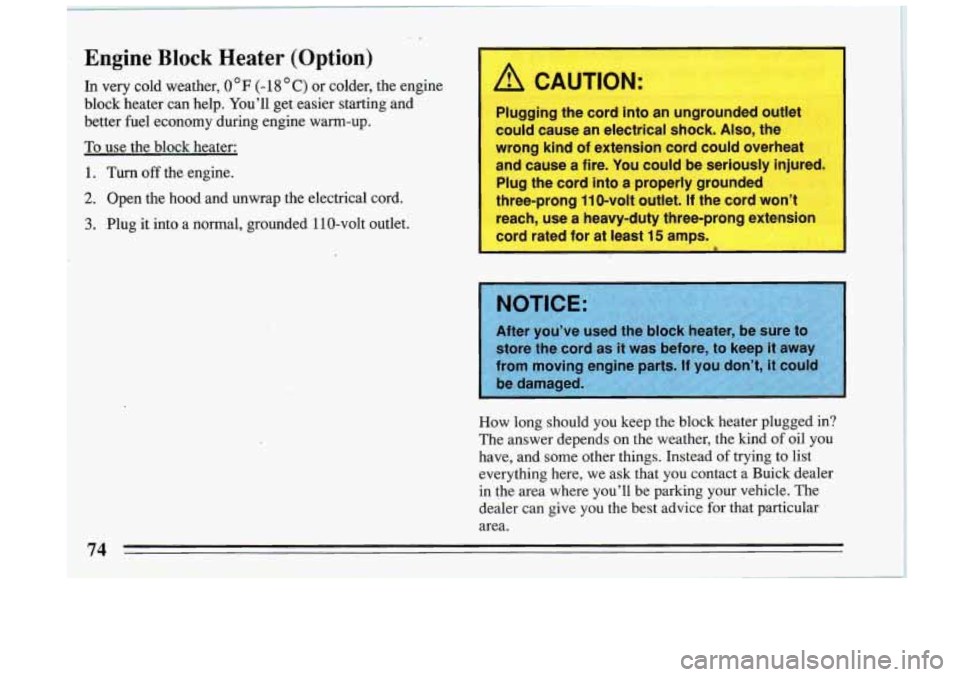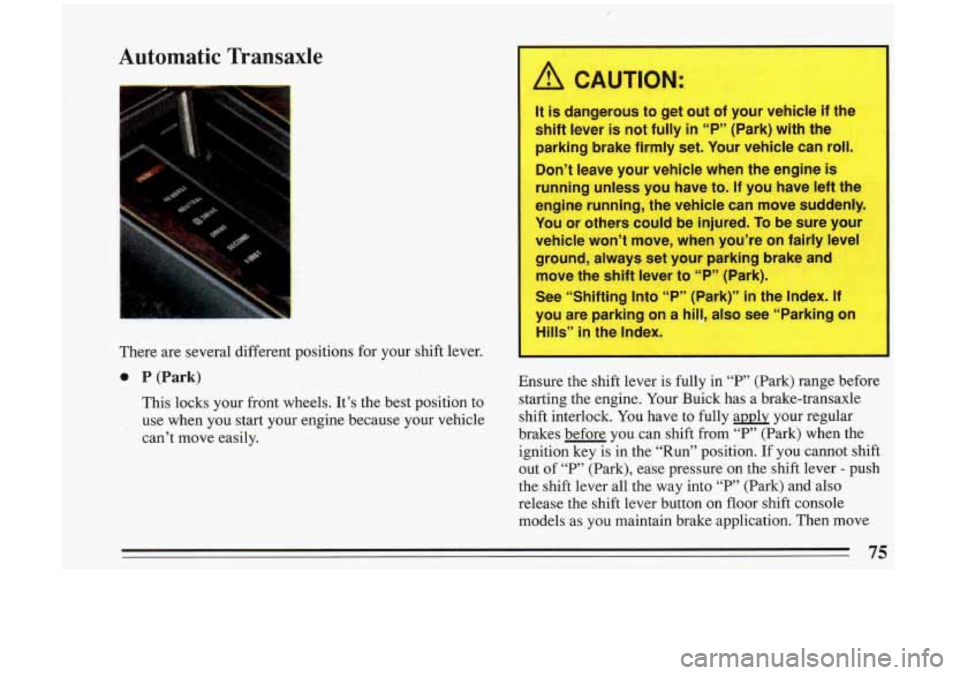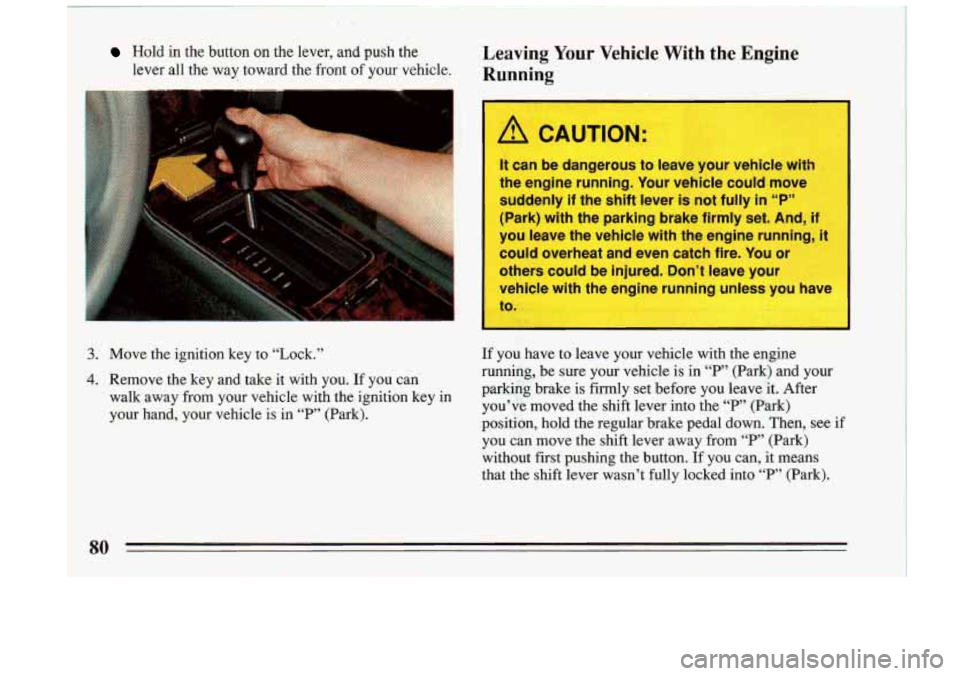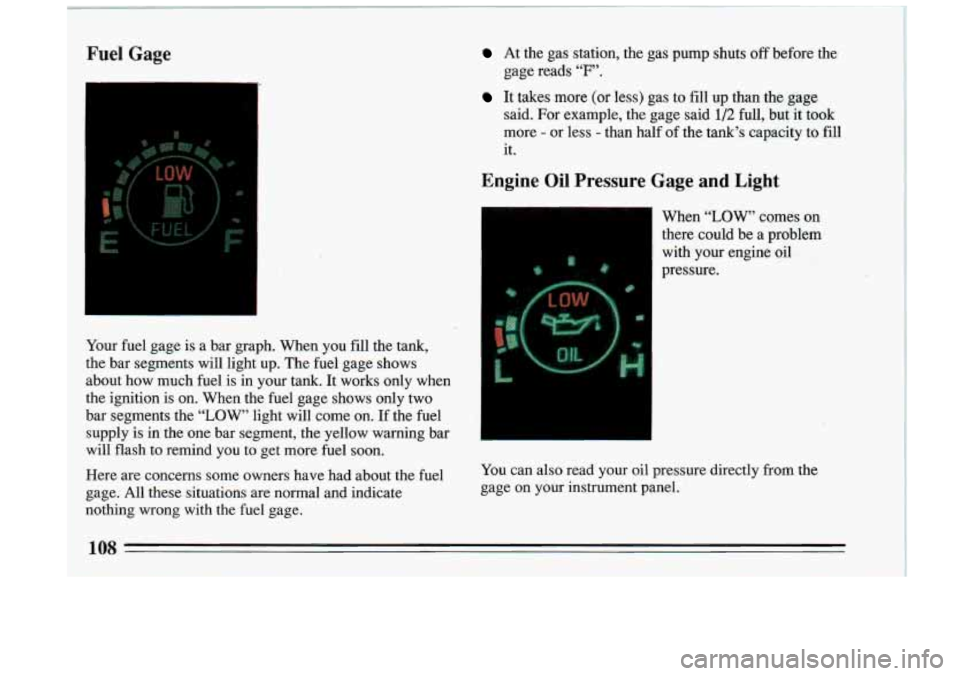Page 76 of 324

Engine Block Heater (Option)
In very cold weather, 0 F (- 18 C) or colder, the engine
block heater can help. You’ll get easier starting and
better fuel economy during engine warm-up.
j To use the block heater: I
I. Turn off the engine.
L. Open the hood and unwrap the electrical cord.
1 3. Plug it into a normal, grounded 110-volt outlet.
A CAUTION:
Plugging the cord into an ungrounded outlet
could cause an electrical shock.
Also, the
wrong kind of extension cord could overheat
and cause
a fire. You could be seriously injured.
Plug the cord into
a properly grounded
three-prong 110-volt outlet.
If the cord won’t
reach, use
a heavy-duty three-prong extension
cord rated for at least
15 amps.
How long should you keep the block heater-plugged in?
The answer depends on the weather, the kind
of oil you
have, and some other things. Instead
of trying to list
everything here, we ask that you contact
a Buick dealer
in the area where you’ll be parking your vehicle. The
dealer
can give you the best advice for that particular
area.
74
Page 77 of 324

Automatic- Transaxle
There are SL . dral different positions for your shift lever.
0 P (Park)
This locks your front wheels. It’s the best position to
use when you start your engine because your vehicle
can’t move easily.
A CAU ION:
It is dangerous to get out of your vehicle if the
shift lever
is not fully in “P” (Park) with the
parking brake firmly set. Your vehicle can roll.
Don’t leave your vehicle when the engine
is
running unless you have to. If you have left the
engine running, the vehicle can move suddenly.
You or others could be injured.
To be sure your
vehicle won’t move, when you’re on fairly level
ground, always set your parking brake and move the shift lever to “P” (Park).
See “Shifting Into “P” (Park)”
in the Index. If
you are parking on a hill, also see “Parking on
Hills” in the Index.
L
Ensure the shift lever is fully in “P’ (Park) range before
starting the engine. Your Buick has a brake-transaxle
shift interlock. You have to fully apply your regular
brake.s before you can shift from
“P’ (Park) when the
ignition key is in the “Run” position. If you cannot shift
out of
“P’ (Park), ease pressure on the shift lever - push
the shift lever all the way into “P” (Park) and also
release the shift lever button on floor shift console models as you maintain brake application. Then move
75
Page 78 of 324
the shift lever into the gear you wish. (Press the shift
lever button before moving the shift lever
on floor shift
console models.) See “Shifting Out
of ‘P’ (Park)’? in this
section.
0 R (Reverse)
Use this gear to back up.
76
I
A CAUTION:
To rock your vehicle back and forth to get out of snow,
ice or sand without damaging your transaxle, see
“If
You’re Stuck: In Sand, Mud, Ice or Snow” in the Index.
N (Neutral)
In this position, your engine doesn’t connect with the wheels.
To restart when you’re already moving, use
“N” (Neutral) only. Also, use “N’ when your vehicle
is being towed.
Shifl J out of “P” (Park) or “N” (Neutral) while
your engine
is “racing” (running at high speed)
is dangerous. Unless your foot is firmly on the
brake pedal, your vehicle could move very
rapidly. You could lose control and
hit people or
objects. Don’t shift out
of “P” (Park) or “N”
(Neutral) while your engine is racing.
I
Page 81 of 324
To release the parking
brake:
I
Hold the regular brake
pedal down. Pull the brake
release lever.
Shifting Into 66 P S? (Park)
A CAUTION:
It can be dangerous to get out of your vehicle if
the shift lever is not fully in “P” (Park) with the
parking brake firmly set. Your vehicle can roll.
If you have left the engine running, the vehicle
can move suddenly. You or others could be
injured.
To be sure your vehicle won’t move,
when you’re on fairly level ground, use the
steps that follow. If you are parking on a
hill,
also see “Parking On Hills” in the Index.
1. Hold the brake pedal down with your right foot and
2. Move the shift lever into “P” (Park) position like
set the parking brake.
this:
If YOU are on a hill: See “ Parking on Hills” in the Index.
That section show$ how to turn your front wheels.
79
Page 82 of 324

Hold in the button on the lever, and push the Leaving Your Vehicle With the Engine
I lever all the way toward the front of your vehicle. Running
3. Move the ignition key to “Lock.”
4. Remove the key and take it with you. If you can
walk away from your vehicle with the ignition key in
your hand, your vehicle is in
“P)’ (Park).
A CAUTION:
It can be dangerous to leave your vehicle with
the engine running. Your vehicle could move
suddenly
if the shift lever is not fully in “P”
(Park) with the parking brake firmly set. And,
if
you leave the vehicle with the engine running, it
could overheat and even catch fire. You or
others could be injured. Don’t leave your
vehicle with the engine running unlesr --ou have
to.
I
If you. have to leave your vehicle .with the engine
running, be sure your vehicle is in
“P” (Park) and your
parking brake is firmly set before
you leave it. After
you’ve moved the shift lever into the
“P” (Park)
position, hold the regular brake pedal down. Then, see if
you can move the shift lever away from “P,’ (Park)
without first pushing the button.
If you can, it means
that the shift lever wasn’t fully locked into
T“ (Park).
so
Page 85 of 324
.I
CAUTlOf _. [lConltlinulecJ~
It can be dangerous to get out of your vehicle i,.
tlhe shiift lever is not flullly in1 T” (Park) with the
parking brake
firmly set. Your vehic’le can roll.
!Don’t leave your veh!icle when the engine
is
running unless you have to. If you’ve left the
engine irunning, th8e vehicle can move su’ddenly.
You or others could
be ‘injured. To be sure your
vehic’le w&t move, even when you,’re
on fairly
level ground,
always set your parking br’ake a’nd
move the shift lever to
‘T’’ (Park).
Follow the proper steps to be sure your vehicle
won’t Imove., See Shifting Into’ ’~P’ (Park) in the
Index,.
If you are parkiing on a hil’l, also see “Pariking on
Hills” in the Index.
Retained Accessory Power
After the ignition is turned off, and before any door is
opened, the following systems will work for ten
minutes:
1’
Power windows
0 Radio
@ Clock (with radio off)
0 Windshield wiper/waSher
0 Astroroof (option) I
83
Page 99 of 324
Twilight Sentinel
Twilight Sentinel turns your headlights
on and off by
sensing how dark it
is
outside.
To operate
it, leave the light switch off and move the
Twilight Sentinel control to any position but
OFF.
If you move the control. all the way to MAX, your lights
will remain on for three minutes after you turn
off your
engine.
If you move the control almost all the way in the
other direction, the lights will
go off quickly when you
turn off your engine. You can change this delay time
from only a few seconds to three minutes. Your
Twilight Sentinel and Daytime Running Lights
(Canada Only) work with the light sensor
on top of your
instrument panel. Don’t cover it up, if you
do it will read
“dark” and your lights will come on.
97
Page 110 of 324

Fuel Gage
I
Your fuel gage is a bar graph. When you fill the tank,
the bar segments will light up. The fuel gage shows
about how much fuel is in your
tank. It works only when
the ignition is on. When the fuel gage shows only two
bar segments the
“LOW’ light will come on. If the fuel
~ supply is in the one bar segment, the yellow warning bar
’ will flash to remind you to get more fuel soon.
At the gas station, the gas pump shuts off before the
gage reads
“F’.
It takes more (or less) gas to fill up than the gage
said. For example, the gage said
1/2 full, but it took
more
- or less - than half of the tank’s, capacity to fill
it.
Engine Oil Pressure Gage and Light
When “LOW, comes on
there could be a problem
with your engine oil
pressure.
~ Here are concerns some owners have had about the fuel You
can also read your oil pressure directly from the
~ gage. All these situations are normal and indicate gage on you\
r instrument panel.
I
nothing wrong with the fuel gage.
j 108 I ~ 1 1